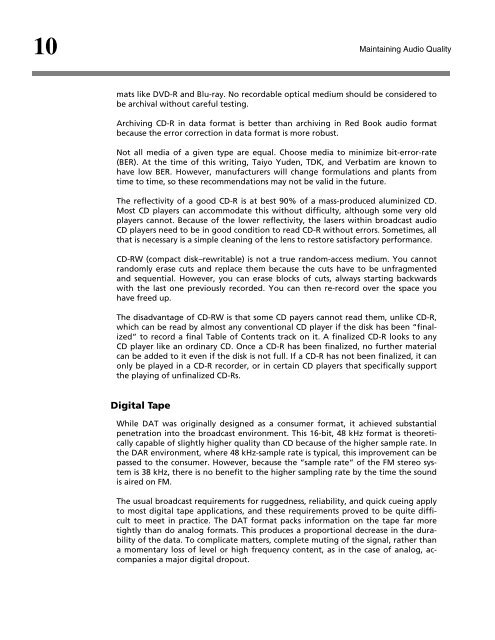Maintaining Audio Quality in the Broadcast Facility 2011 - Orban
Maintaining Audio Quality in the Broadcast Facility 2011 - Orban
Maintaining Audio Quality in the Broadcast Facility 2011 - Orban
Create successful ePaper yourself
Turn your PDF publications into a flip-book with our unique Google optimized e-Paper software.
10<br />
<strong>Ma<strong>in</strong>ta<strong>in</strong><strong>in</strong>g</strong> <strong>Audio</strong> <strong>Quality</strong><br />
mats like DVD-R and Blu-ray. No recordable optical medium should be considered to<br />
be archival without careful test<strong>in</strong>g.<br />
Archiv<strong>in</strong>g CD-R <strong>in</strong> data format is better than archiv<strong>in</strong>g <strong>in</strong> Red Book audio format<br />
because <strong>the</strong> error correction <strong>in</strong> data format is more robust.<br />
Not all media of a given type are equal. Choose media to m<strong>in</strong>imize bit-error-rate<br />
(BER). At <strong>the</strong> time of this writ<strong>in</strong>g, Taiyo Yuden, TDK, and Verbatim are known to<br />
have low BER. However, manufacturers will change formulations and plants from<br />
time to time, so <strong>the</strong>se recommendations may not be valid <strong>in</strong> <strong>the</strong> future.<br />
The reflectivity of a good CD-R is at best 90% of a mass-produced alum<strong>in</strong>ized CD.<br />
Most CD players can accommodate this without difficulty, although some very old<br />
players cannot. Because of <strong>the</strong> lower reflectivity, <strong>the</strong> lasers with<strong>in</strong> broadcast audio<br />
CD players need to be <strong>in</strong> good condition to read CD-R without errors. Sometimes, all<br />
that is necessary is a simple clean<strong>in</strong>g of <strong>the</strong> lens to restore satisfactory performance.<br />
CD-RW (compact disk–rewritable) is not a true random-access medium. You cannot<br />
randomly erase cuts and replace <strong>the</strong>m because <strong>the</strong> cuts have to be unfragmented<br />
and sequential. However, you can erase blocks of cuts, always start<strong>in</strong>g backwards<br />
with <strong>the</strong> last one previously recorded. You can <strong>the</strong>n re-record over <strong>the</strong> space you<br />
have freed up.<br />
The disadvantage of CD-RW is that some CD payers cannot read <strong>the</strong>m, unlike CD-R,<br />
which can be read by almost any conventional CD player if <strong>the</strong> disk has been “f<strong>in</strong>alized”<br />
to record a f<strong>in</strong>al Table of Contents track on it. A f<strong>in</strong>alized CD-R looks to any<br />
CD player like an ord<strong>in</strong>ary CD. Once a CD-R has been f<strong>in</strong>alized, no fur<strong>the</strong>r material<br />
can be added to it even if <strong>the</strong> disk is not full. If a CD-R has not been f<strong>in</strong>alized, it can<br />
only be played <strong>in</strong> a CD-R recorder, or <strong>in</strong> certa<strong>in</strong> CD players that specifically support<br />
<strong>the</strong> play<strong>in</strong>g of unf<strong>in</strong>alized CD-Rs.<br />
Digital Tape<br />
While DAT was orig<strong>in</strong>ally designed as a consumer format, it achieved substantial<br />
penetration <strong>in</strong>to <strong>the</strong> broadcast environment. This 16-bit, 48 kHz format is <strong>the</strong>oretically<br />
capable of slightly higher quality than CD because of <strong>the</strong> higher sample rate. In<br />
<strong>the</strong> DAR environment, where 48 kHz-sample rate is typical, this improvement can be<br />
passed to <strong>the</strong> consumer. However, because <strong>the</strong> “sample rate” of <strong>the</strong> FM stereo system<br />
is 38 kHz, <strong>the</strong>re is no benefit to <strong>the</strong> higher sampl<strong>in</strong>g rate by <strong>the</strong> time <strong>the</strong> sound<br />
is aired on FM.<br />
The usual broadcast requirements for ruggedness, reliability, and quick cue<strong>in</strong>g apply<br />
to most digital tape applications, and <strong>the</strong>se requirements proved to be quite difficult<br />
to meet <strong>in</strong> practice. The DAT format packs <strong>in</strong>formation on <strong>the</strong> tape far more<br />
tightly than do analog formats. This produces a proportional decrease <strong>in</strong> <strong>the</strong> durability<br />
of <strong>the</strong> data. To complicate matters, complete mut<strong>in</strong>g of <strong>the</strong> signal, ra<strong>the</strong>r than<br />
a momentary loss of level or high frequency content, as <strong>in</strong> <strong>the</strong> case of analog, accompanies<br />
a major digital dropout.



![[PDF] Using the ITU BS.1770-2 and CBS Loudness Meters ... - Orban](https://img.yumpu.com/50629372/1/190x245/pdf-using-the-itu-bs1770-2-and-cbs-loudness-meters-orban.jpg?quality=85)






![[PDF] Optimod-FM Feature Comparison - Orban](https://img.yumpu.com/41741615/1/190x245/pdf-optimod-fm-feature-comparison-orban.jpg?quality=85)






